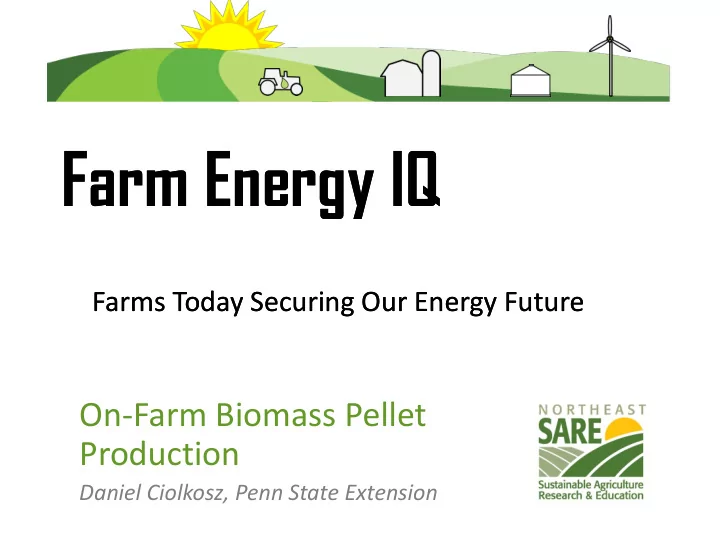

Farm Energy IQ Farm Energy IQ Farms Today Securing Our Energy Future Farms Today Securing Our Energy Future On-Farm Biomass Pellet Production Daniel Ciolkosz, Penn State Extension
Farm Energy IQ On-Farm Biomass Pellet Production
Overview • Introduction • Pelleting equipment • Keys to successful operation • Markets and uses for pellets
The Pellet Industry • Primarily producing wood pellets • Started as a way to use sawdust at sawmills • Large operations – tons per hour • Two main markets – Domestic – home heating (dominant market in the Northeast U.S.) – International – power plants in Europe, Asia
Opportunities for On-Farm Production • Can grow feedstock – wood or grass • Smaller equipment is available • Produce own heating fuel or sell to others • Buy local food, buy local energy!
Common Feedstocks
Common Feedstocks
Common Feedstocks
Common Feedstocks
Pellet Theory - Densification • Downward pressure • Transverse and longitudinal compression – Roller “dynamic plug” Granular Feedstock • Cooling/hardening Die Pellets Exit Die
Downward Pressure of Roller Lateral and Maximum Transverse Back Compression Pressure Friction Resisting Movement, Creating Back Pressure Minimum Back Pressure
What is in Biomass? Extractives (~5% by mass) Hemicellulose (~23% by mass) Lignin (~27% by mass) Cellulose (~45% by mass)
Pellet Theory – Binding
Pelletizing equipment
Harvest
Storage
Storage
Grinding 1. Tub grinder 1 2. Hammer mill 3. Collection system 3 2
Conditioning
Pelleting
Cooling • As it cools, the pellet dries and hardens • Commercial facilities use cooling bins with forced air movement • Small operations can use open air drying on racks or similar
Packaging • Plastic, 18-kg (40-lb) bags are most common • Must be sealed to prevent moisture uptake • Supersacks work for bulk sales
Keys to Successful Operation
Keys to Successful Operation – Particle Size • Measured by screen size of grinder, nominally the maximum dimension of particle • Too small – excessive grinding energy • Too large – difficulty passing through die • Recommendation – use screen size no larger than diameter of die
Keys to Successful Operation – Moisture Levels 9 8 7 Pellet Quality Rating 6 5 4 3 2 1 0 0 5 10 15 20 25 30 35 Moisture Content (%)
Keys to Successful Operation – Pre-Mixes • Start batch with pre-mix (#1) to develop dynamic 2 plug that flows and provides back 1 pressure • Follow with feedstock (#2)
Keys to Successful Operation – Die Tightness
Keys to Successful Operation – Pelletizer Speed
Keys to Successful Operation – Loading Methods • Open hopper machines – Loading the material all at once (“dumping”) works better than does gradual feed • Sealed hopper machines – Gradual feed may be better
Keys to Successful Operation – Finishing • Feedstock can harden and stick if left in the die to cool • Finish each run with a weaker material that will not clog the die • Dried distiller grains (DDGs) and soy have both proven effective
Keys to Successful Operation – BE SAFE! • Potential hazards include – Dust (inhalation, combustion) – Moving parts – Hot parts • Dress appropriately • Assess risks • Act appropriately
Markets and Uses - Heat Large, Commercial Pellet Boilers
Markets and Uses – Sorbents
Markets and Uses - Bedding
Markets and Uses – Mulch
Example Startup Costs Description Amount per Acre Total Cost Startup Costs: Fixed Costs - $1,103.13 $44,125.00 Equipment Variable Costs – Site $72.11 $2,582.64 Prep Variable Costs – $60.37 $2,241.12 Planting Variable Costs – $72.33 $2,205.53 Establishment
Example Operating Costs Description Amount per Acre Total Cost Ongoing Costs: Variable Costs – $41.23 $1,649.05 Harvest Variable Costs – $3.36 $134.45 Storage Variable Costs - $194.95 $7,798.00 Pelleting Total: $239.54 $9,581.50 That’s $ 88.72 per ton of pellets (not including labor)
Operating Costs Buildings, Land Cost Packaging Labor 11% 0% 0% Equipment Upkeep 16% Fuel and Lube (tractors, mills) 73%
Labor Requirements Harvest Storage 4% 1% Pelleting 95% That’s 12.5 hours per ton of pellets
Farm Energy IQ Pelleting Demo
Farm Energy IQ Farm Energy IQ Farms Today Securing Our Energy Future Farms Today Securing Our Energy Future Questions?
Recommend
More recommend